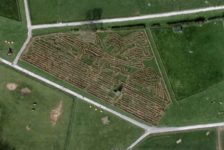For a number of years, the landscape architecture profession has seen a rapid increase in the adoption of three-dimensional modeling to aid the creative process and express design intent. As a result, this increase has fueled a surge in the slew of 3D modeling software programs on the market, with the majority bearing a hefty price tag. Whether you’re a penniless newbie or a seasoned professional, choosing a new and foreign piece of software can often prove bemusing. Here are five programs to consider, both gratis and costly.
3D Modeling Software
1. Blender Ultimately aimed toward the 3D artist market, Blender makes the list because it presents a free, open source application for learning the art and craft of the 3D modeling world. The latest version of Blender features a slick interface comprised of three windows, and can be completely customized to your liking. The layout may seem daunting to curious newcomers, so the software aptly includes a well-structured manual and the Blender website contains copious step-by-step tutorials. Being an open source project, Blender benefits from user-based development, resulting in continuous improvements and bug fixes. Possessing a versatile interface and all the tools needed for 3D modeling, animation, and rendering, Blender is perfect for those not wanting to open their wallets. 2. SketchUp Make WATCH: Make Ideas Real with SketchUp This little gem also eschews the trend of exorbitantly priced 3D modeling software and presents a free, easy-to-use alternative. SketchUp is a fast, flexible, and fun application that allows you to create, view, and modify 3D ideas quickly and easily. Users can even integrate with Google Earth, posting their latest creations for the world to see. Despite its ease of use, SketchUp isn’t scant on functionality, and includes the usual collection of drawing and filling tools you would expect. Being free, SketchUp does lack some of the advanced features many of its heavyweight rivals possess. But with its no-frills interface, simple logic, and abundance of helpful hints and guides, it’s the perfect tool for beginner and intermediate designers alike. 3. AutoDesSys Bonzai3d The guys at AutoDesSys have taken a fresh approach to 3D modeling with Bonsai3d, intending to provide rapid conceptual modeling in a similar vein to SketchUp. The two are, however, rather different in their approach and the breadth of their toolsets. Bonsai3d has a collection of specific tools, whereas SketchUp tends to stick to a few general ones.

Credit: Evan Troxel, Method Digital Training, https://getmethod.com
- Top 10 Hints & Tips For SketchUp
- 10 AutoCAD Hacks for Beginners!
- Computer Aided Software for Landscape Architects: The Essential Guide
5. Autodesk 3ds Max Considered a major player within the 3D modeling community, 3ds Max is capable of delivering a powerful rendering experience. The software offers polygon, subdivision, and NURBS modeling, resulting in the creation of smooth surfaces with supreme accuracy. Fully customizable interfaces help streamline work space and enhance productivity, while a multitude of editing tools allow precise model manipulation. A relatively new addition to 3ds Max is the population feature – giving you the ability to add people to a scene to give it life, ideal for landscape architecture modeling. A huge advantage of using 3ds Max is its support of AutoCAD pattern files, making it possible to create animated and visually interesting CAD illustrations. Mastering 3ds Max presents a steep learning curve due its cutting-edge features, and can be intimidating to beginners. As with all Autodesk products, online tutorials are available to help you tackle any problem you may encounter. Predominately geared toward professional environments, Autodesk 3ds Max is one of the best options for your three-dimensional needs, hence its astronomical price – ranging from $3,500 to $4,000 USD. WATCH: 3D Architecture Animation – demo reel 2008 Of the plethora of 3D modeling software out there today, these five programs are among the best for use in landscape architecture. Whatever your choice, take the time to learn the program inside out. In this day and age, it’s a valuable skill to have. Recommended Reading:
- SketchUp 2014 For Dummies by Aidan Chopra
- The Complete Guide to Blender Graphics, Second Edition: Computer Modeling and Animation by John M. Blain
Article by Paul McAtomney Return to Homepage Featured image: Julia Garan / shutterstock.com
Published in Blog








